Five national parks in five days. That sounds pretty ambitious if you’re just trying to check them off a list, but what if you’re trying to make pictures? Is that even possible? That was our challenge on a recent workshop I helped teach for Mentor Series. As usual, the answer revolved around careful planning (and a bit of luck).
Utah’s blessed with some of the most dramatic National Parks in the U.S. That unique southwestern landscape of desert, sandstone, rock formations, canyons and mesas draws visitors from around the world. It’s not the easiest area to get to, but if you look carefully at a map, you realize that by starting in Las Vegas and ending in Salt Lake City you can string several of these parks together in one trip. Which is exactly what we did.
Our first stop out of Vegas was Zion National Park. The original plan had us using the Emerald Pools Trails to access three different areas there. But best laid plans and all that… Over the winter there’d been a landslide and major parts of the trail had to be closed. We hoped they’d be open by the time of our arrival, but no luck there. Unfortunately, that’s something you run into regularly in photography – what do you do when things don’t work out the way you’d hoped? In all the years I worked in newspapers, that’s the most important lesson I learned. You simply have to make the best of what’s there in the time you have. So we changed our plans. Our two groups instead spent that afternoon using the park shuttles to visit Court of the Patriarchs and Weeping Rock.

In Bryce National Park our group’s first stop was at Court of the Patriarchs. My favorite picture there was down in the rivered when I discovered someone had made a horse head out of mud and tucked it into a shattered tree trunk. Since it was in shadow, I used a small flash held off to the left, setting my base exposure for the sky behind. Nikon D810, Manual exposure, ISO 100, 1/160 at f/13, Nikkor 18-35mm lens at 21mm. Photo copyright Reed Hoffmann.
While Court of the Patriarchs refers to a few spires of rock, most of us found our best photos along the river in front of them. It’s easy to get mesmerized by the grand vistas at these parks, so I reminded the group to look down and find those less majestic shots too. Weeping Rock, being up a hillside, gave us the opportunity to work with one of those grand vistas, framing it from underneath the dripping overhang.
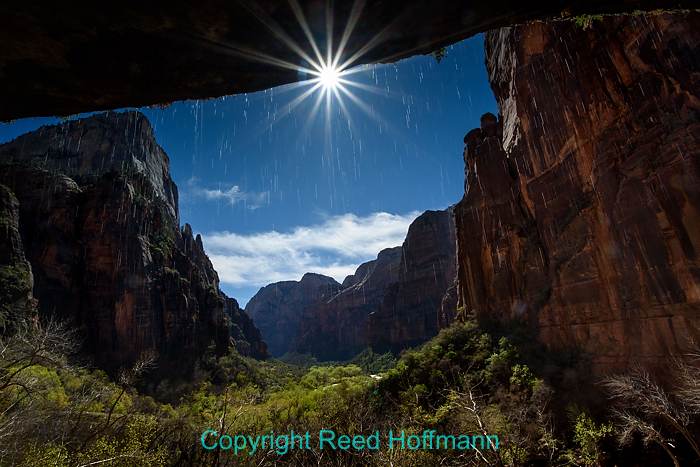
Our second stop at Zion was at Weeping Rock. A short hike up to it gives you the opportunity to stand under the ledge, shielded from the dripping water. Using a small aperture, we were able to create a starburst effect of the sun just poking over the overhang. Nikon D810, Aperture Priority, ISO 100, 1/30 at f/22, 0.0 EV, Nikkor 18-35mm lens at 18mm. Photo copyright Reed Hoffmann.
After a quick trip back to Springdale (where we were staying) for dinner, we returned for a sunset shoot. One of the classic scenes for that is a view of The Watchman, a mountain that catches the last rays of the setting sun. We picked a nice spot above the river, as it would give us a good foreground for the photo, the water reflecting the last light in the sky.
The next morning we returned before sunrise for a shoot of The Temple of the Virgins, from behind one of the visitor centers. As the sun comes up, it slowly lights those rocks from top to bottom. In addition to the regular photos, I also set one of my cameras to shoot a time-lapse, and did some slow shutter-speed zooms with the second camera to create a different look.
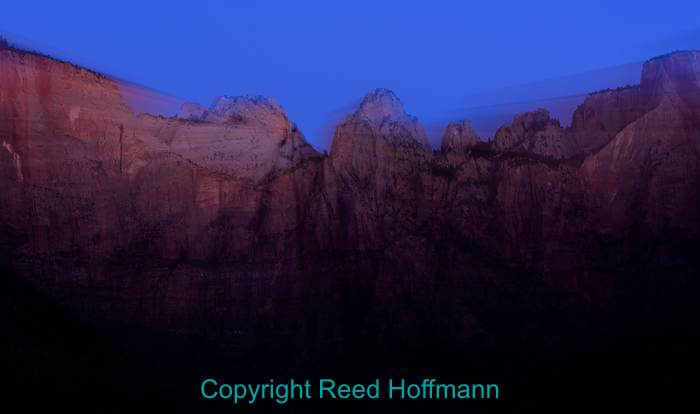
During our sunrise shoot at Temple of the Virgins in Zion, I played a little with using a slow exposure and zooming the lens while doing that. Having the camera on a tripod really helps to make this work. Nikon D810, Aperture Priority, ISO 100, 3-seconds at f/11, -0.3 EV, Nikkor 24-120mm lens at 65mm. Photo copyright Reed Hoffmann.
After that it was back to town for breakfast, then pack our gear and head out. On the way out of Zion towards Bryce, we stopped at Checkerboard Mesa to take advantage of the unique vertical and horizontal lines that erosion’s carved into it.
The drive to Bryce isn’t very far, so we made a couple of stops for lunch and to shoot. That still got us to the park in plenty of time to visit Bryce Point before checking into the hotel, and return again to the park for a sunset shoot. We walked the trail between Sunrise and Sunset Points because it let us take advantage of not only the different overviews, but venture down a few of the trails that go into the famous hoodoos. Those “hoodoos” are strangely shaped spires of orange and yellow sandstone, and the huge numbers of them packed densely together is what makes Bryce unique.
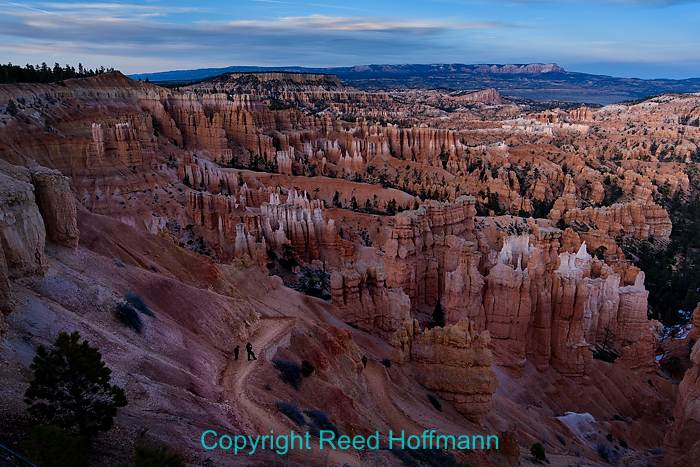
Bryce National Park and its famous hoodoos at sunset. Having the two people on the trail really gives the image a focal point, and the curve of the trail leads the eye right there. Nikon D810, Aperture Priority, ISO 400, 1/80 at f/5, -0.3 EV, Nikkor 18-35mm lens at 24mm. Photo copyright Reed Hoffmann.
The next morning we were back for a sunrise shoot, and the sun cooperated with beautiful early-morning light. While Zion is mostly about being in a valley looking up, Bryce is all about looking down at those hoodoos. There was some fog mixed in with the trees in the distance, which added a nice touch. With the brightness of the sky, graduated neutral density filters came in handy. Using one helped lower the brightness of the sky so we could still hold plenty of detail in the foreground. As always, we looked for as many different photos as possible, not just the wide shots. There were ravens soaring over the rocks, stunted trees that made good foreground subjects and of course zoomed-in photos of groupings of hoodoos.
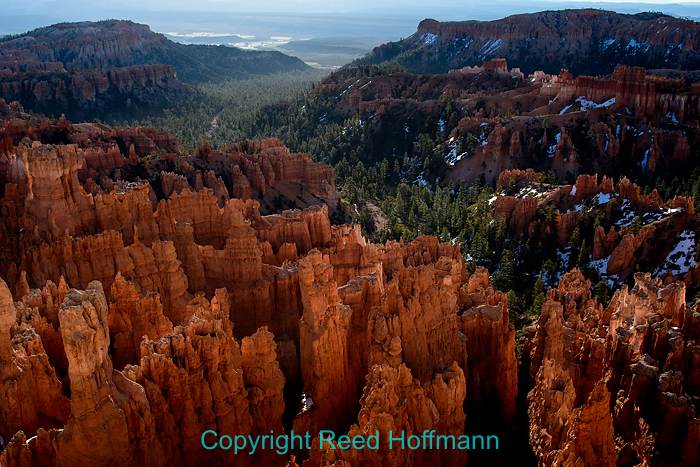
Sunrise at Bryce is spectacular, but a little surprising if you haven’t been there before. It actually comes from behind the hoodoos, but the light reflecting back into them gives that classic glow to the rocks. Nikon D500, ISO 100, 1/100 at f/8 in Aperture Priority, -0.3 EV, Nikkor 24-120mm f/lens at 36mm. Photo copyright Reed Hoffmann.
After that, it was back for breakfast, then packing and heading out again. These “shoot-and-move” trips can be exhausting, but I like having the opportunity to see so many different things. I know that once I get home I’ll be able to catch up on sleep, so don’t mind a few long days, especially if there’s fabulous scenery to photograph.
On this day we were off to Capitol Reef National Park. We took the scenic route through Grand Staircase Escalante, which was as beautiful as advertised. We also made a stop along the Escalante River to stretch our legs and explore a bit. Crossing over the mountains, topping 9,000 feet, we even saw a lot of snow. Our timing was just about right, arriving at Capitol Reef a couple of hours before sunset. That gave us the perfect amount of time to do the Scenic Drive. It’s an out-and-back road, with plenty of pullouts to stop, get out and shoot. We finished at the Gifford Homestead, where one of the horses had the courtesy to come out and pose for us by the barn, with the mountains as a backdrop.

Good example of a detail shot along the Escalante River, but done with a wide-angle lens to give a sense of place. Note also that while I’m at f/16, the trees in the background are out of focus because I’m so close to the cactus. Nikon D810, Aperture Priority, ISO 100, 1/80 at f/16, 0.0 EV, Nikkor 18-35mm lens at 20mm. Photo copyright Reed Hoffmann.
After another late dinner (such is the price of shooting sunset), the next morning we were off to Moab. This little adventure-sports town is in a great location, just outside Arches National Park with Canyonlands close by. Here we’d actually stay for two nights, using those days to explore the two parks. After checking into our hotel and a quick lunch, it was off to Arches.
This is my favorite park in the area thanks to the great variety of photos it offers and easy access. It’s hard to drive a quarter mile and not want to stop. That afternoon we had three places we were going to visit. First was Courthouse Towers, a nice introduction to the park. Some of us worked the big rocks near the parking area, experimenting with shooting through and from underneath them. Others in the group found interesting chambers carved out of the rock by erosion on the opposite side of the road. With the day being overcast, many of us switched our cameras to Monochrome (black-and-white). Since we weren’t going to have the contrast that sunlight would create (and the resulting stronger colors and rich blue skies), this let us work with the simpler tones of gray and add some drama to the sky.
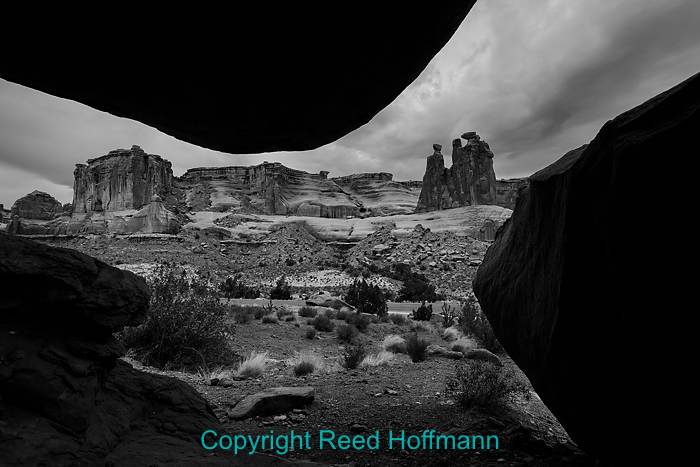
Out among the rocks near Courthouse Towers, the lack of sun gave us a good reason to shoot some black-and-white. And with a fairly blah sky, I framed from underneath a large boulder to minimize that sky. Nikon D810, Aperture Priority, ISO 200, 1/125 at f/11, 0.0 EV, Nikkor 18-35mm lens at 18mm. Photo copyright Reed Hoffmann.
From there it was on to the North and South Windows. This is a pair of arches, which by themselves are beautiful to photograph. But if you’re a bit of a daredevil, you can climb through the North Window and then scramble down and back up the rocks across from it. From that spot you’ll have a view of the South Window framed through the north one. About a half-dozen of our group managed that little adventure.
Our final stop of the day was Delicate Arch. This is perhaps the most famous arch in the southwest, and is what’s pictured on the Utah license plate. You get to it after a 1.5-mile walk, which is harder than it sounds because it’s mostly uphill. We’d allowed one hour for that hike to make sure we arrived at the arch before sunset, but that seemed pointless when we reached the trailhead. The sky was still heavily overcast. And this is where we got incredibly lucky. About fifteen minutes after everyone reached the arch, the sun broke through the clouds. For just over two-minutes, we had beautiful, warm light on the arch, then it was gone. Poof! It was the only sunshine we’d seen all afternoon, and incredibly enough, it was right when we needed it. I’ll tell you, that was one happy group hiking back down to the bus.

Believe it or not, this was the only sun we had all afternoon, and came out shortly after we arrived at Delicate Arch. And by the time stamps on my photos, it lasted less than three minutes. I made a few frames at this angle, then raced around for a closer position before the light faded. Nikon D810, Aperture Priority, ISO 125, 1/60 at f/5.6, -0.3 EV, Nikkor 18-35mm lens at 22mm. Photo copyright Reed Hoffmann.
For the final day of our trip, we gave people the option to sleep in or come out for one more morning shoot. About half the group showed up, and we headed back to the park to explore Devil’s Garden. This is a gently rolling trail which leads back to several arches, and a great place to simply wander and look for interesting pictures. That’s where I made some of my favorite photos of the trip. I found some massive sandstone fins with dramatic light on them, and various patterns in the sand and rock. It was a lovely morning.

This was one of my favorite photos from the trip, made during a morning hike at Devil’s Garden. Landscape Arch is directly behind me here, but I found this scene much more appealing. Nikon D810, Aperture Priority, ISO 160, 1/500 at f/6.3, 0.0 EV, Nikkor 24-120mm lens at 34mm. Photo copyright Reed Hoffmann.
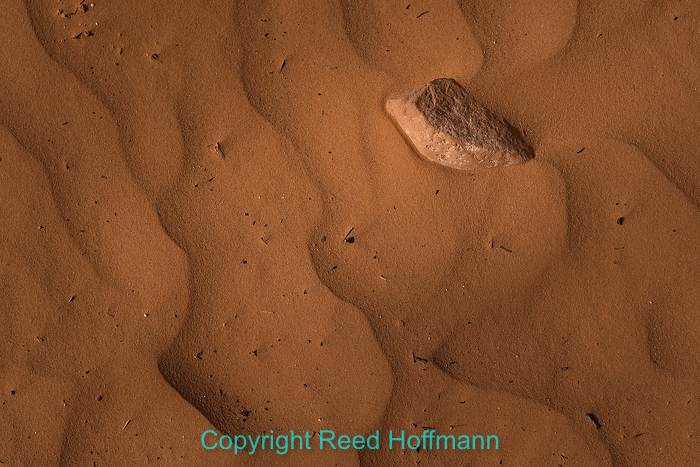
Another photo from the morning at Devil’s Garden. The blowing sand was a pain for our eyes and gear, but created some beautiful patterns. The lone rock, while just a small part of the image, made the picture. Nikon D500, Aperture Priority, ISO 100, 1/640 at f/5.6, -0.3 EV, Nikkor 24-120mm lens at 60mm. Photo copyright Reed Hoffmann.
Late that afternoon the whole group climbed onto the buses once more for our final outing. Our original plan had us going to Island in the Sky, in Canyonlands, but we decided instead to visit Dead Horse Point State Park. Looking at photos online showed that it offered some beautiful vistas, and being closer to Moab would give us more time to shoot. That’s always a challenge on a trip like this. You want to pack in as many great photo stops as you can, but you also have to allow enough time to not just shoot and run, but be able to explore. Figuring out that balance is one of the best things I’ve learned in the fifteen years I’ve been leading trips.
Dead Horse Point did not disappoint. Some of us chose to hike out to the point, making photos along the way, while others took the bus. But we all ended up at the overlook for the last light of the day, and a vista that was classic southwestern. It was a fitting finish to a great trip.
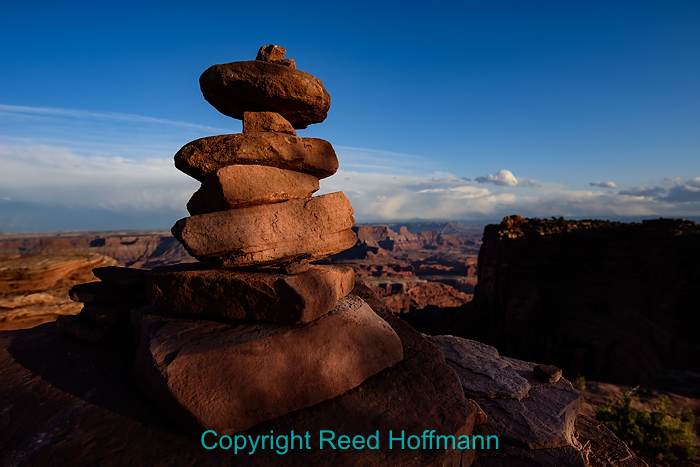
We had a beautiful evening at Dead Horse State Park, and for those of us who chose to hike in to the overlook, there were nice photos to be found. The dappled light makes this photo work. Nikon D810, Aperture Priority, ISO 100, 1/250 at f/6.3, -0.3 EV, Nikkor 18-35mm lens at 24mm. Photo copyright Reed Hoffmann.
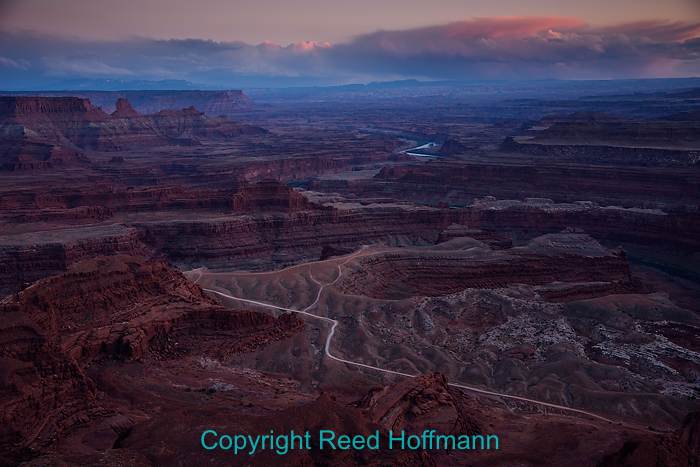
The overlook at the end of the road at Dead Horse State Park was everything we hoped it would be. The road in the foreground leads the viewer’s eye into the photo. Nikon D810, Aperture Priority, ISO 160, 1/15 at f/5, -1.0 EV, Nikkor 24-120mm lens at 40mm. Photo copyright Reed Hoffmann.
By now you realize that my answer to the question, “can you photograph five national parks in five days” is an enthusiastic “Yes!” With careful planning and research, it’s not just possible, but can be a wonderful trip. However, the southwest is also something that, as a photographer, will get into your blood. You’re going to want to return. In fact, I think I’ll do another trip out there this fall. Want to join me?
(If you like this story, please share it with your friends, and let them know about the links about photography I post on my business Facebook page. I’m also on Instagram and Twitter, @reedhoffmann)
